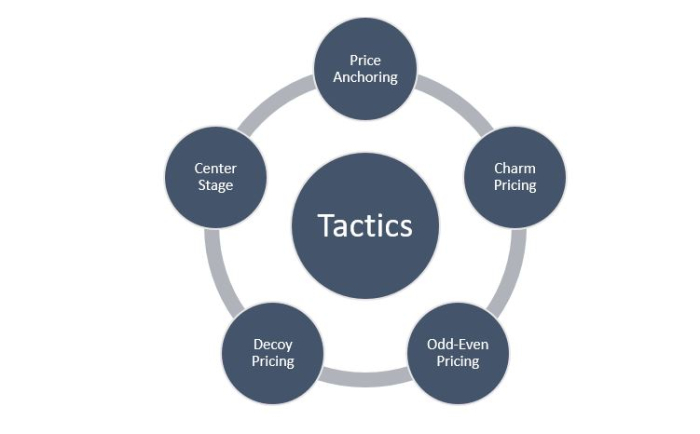
 Data Structure
Data Structure Networking
Networking RDBMS
RDBMS Operating System
Operating System Java
Java MS Excel
MS Excel iOS
iOS HTML
HTML CSS
CSS Android
Android Python
Python C Programming
C Programming C++
C++ C#
C# MongoDB
MongoDB MySQL
MySQL Javascript
Javascript PHP
PHP
- Selected Reading
- UPSC IAS Exams Notes
- Developer's Best Practices
- Questions and Answers
- Effective Resume Writing
- HR Interview Questions
- Computer Glossary
- Who is Who
Price Psychology in Marketing
Have you ever gone shopping and realized as you were leaving that you had overspent? You may certainly confess it. Each person experienced it. If I told you it wasn't your fault, would it help you feel better? Hey, it's true. Deals are especially created to persuade you to spend more money than you anticipated through a variety of psychological pricing methods. Applying retail pricing strategies to other industries' pricing can be quite successful. Let's take a closer look at four of the most well-liked strategies you can employ to boost sales and prevent further mall spending.
The meaning of Psychological Pricing
The technique of putting prices below whole numbers is known as psychological pricing. The premise behind psychological pricing is that consumers will perceive a price reduction as being lower than it actually is. When a consumer is told that a $3.99 item is actually $3 rather than $4 and that the $3.99 price is lower than his $4.00 price, this is an example of psychological pricing in action.
Strategies for Psychological Pricing
Below are a few psychological pricing tactics that are very famous and are only used in the market ?
Price Anchoring
Price anchoring acknowledges that buyers frequently base their decisions excessively on the initial piece of information (the anchor). A jeweler might use a woman's engagement ring, which costs $18,000, as a price anchor at first. Next, present a $15,000 ring. This is significantly more affordable than Anchor, and to the client, it appears to be a "good value." Thus, the consumer is more likely to purchase a second ring than he would have been had he not noticed the anchor.
This is perfect for businesses that use a tiered pricing structure, which sells various iterations of their core product and associated extras at various rates.

Charm Pricing
In order to take advantage of left-digit bias, which causes consumer perceptions and ratings to be disproportionately influenced by the left-most digit of a product price, Charm pricing refers to the utilization of prices ending in 9.
According to research, rounding to the next round price point (such as $600) instead of using a price that ends in "99" (such as $599) can increase sales. Unconsciously, the human mind adds $500 to the $599, therefore the result is $500, not $600. According to a study that is detailed in the book Priceless (opens in new tab), the prices of charms are 24% more than the rounded values.
Perfect for non-luxury firms looking to communicate a "deal".
Odd-Even Pricing
Similar to charm prices but used on a larger scale are even and odd prices. This strategy takes advantage of the notion that customers are psychologically sensitive to specific final figures.
"Odd pricing" are amounts that end in 1, 3, 5, 7, or 9 (for instance, $9.93). A price with an even price is one that ends in a whole number or tenth, such as $20.00 or $20.50. Because they signify the offer in the customer's perception and improve the possibility of a purchase, odd pricing tends to be more attractive. But that doesn't negate the fact that pricing has a purpose as well. Luxury brands frequently maintain their prices in order to convey a premium image.
Companies are not, however, restricted to odd or even costs. For instance, Nike maintains a fixed price for all full-priced items. However, deals with strange prices are displayed in the sales panel (which opens in a new tab).
For luxury goods, even prices work best, whereas odd prices work best for the majority of other goods.
Decoy Pricing
The decoy pricing technique is based on the "decoy effect," according to which people's preferences for the two options vary slightly when a third option that is weaker in all but one way is also given. I have. Her first two selections appear more appealing since the third option is the "lesser" one.
This pricing technique is best for a company where they have more than one top choice for luring clients. For instance, decoy rewards are becoming more known in the news media sector as businesses attempt to convert readers from print to digital media.
Center Stage
The center stage effect is the foundation of this strategy. This indicates that you are drawn to the middle product when presenting a group of the products side by side.
This is appropriate for any business with a range of price options, as long as your preferences are respected.
Examples of Psychological Pricing
Zara

Zara mostly employs a value-based pricing strategy. Instead of emphasizing the company's price expenses, this method concentrates on the customer's impression of value. The company's target market wants attractive clothing but cannot afford the exorbitant cost of luxury clothing companies. Every day, Zara counts broken codes and unsold merchandise.
Amazon
Amazon uses psychological pricing methods as part of its marketing plan, just like other astute merchants. On practically all of its products, Amazon engages in price fixing.
Apple
According to research, customers believe that the costs immediately below that are lower than they actually are. Because Apple has set the price for his iPhone at $999, most customers would mentally round that amount down to $900 rather than up to $1000.
Coca Cola
In order to estimate Original Coke in 2009, Coca-Cola employed a psychometric technique. They used a 2-liter cup of Original Coke, as an illustration, and put the costs as $2.49. The final price was fixed at 9. In order to convince the client's mind that the cost was under $2.50, they did this.
Pricing is a challenge. A sound pricing plan is beneficial. You can anticipate some outcomes if you use psychological insights and tried-and-true strategies. Planning and revising your price strategy, however, can take a lot of work.
Although psychological pricing can be a useful tool for estimating the price of a product, it can also be a component of a brand's larger marketing plan.

